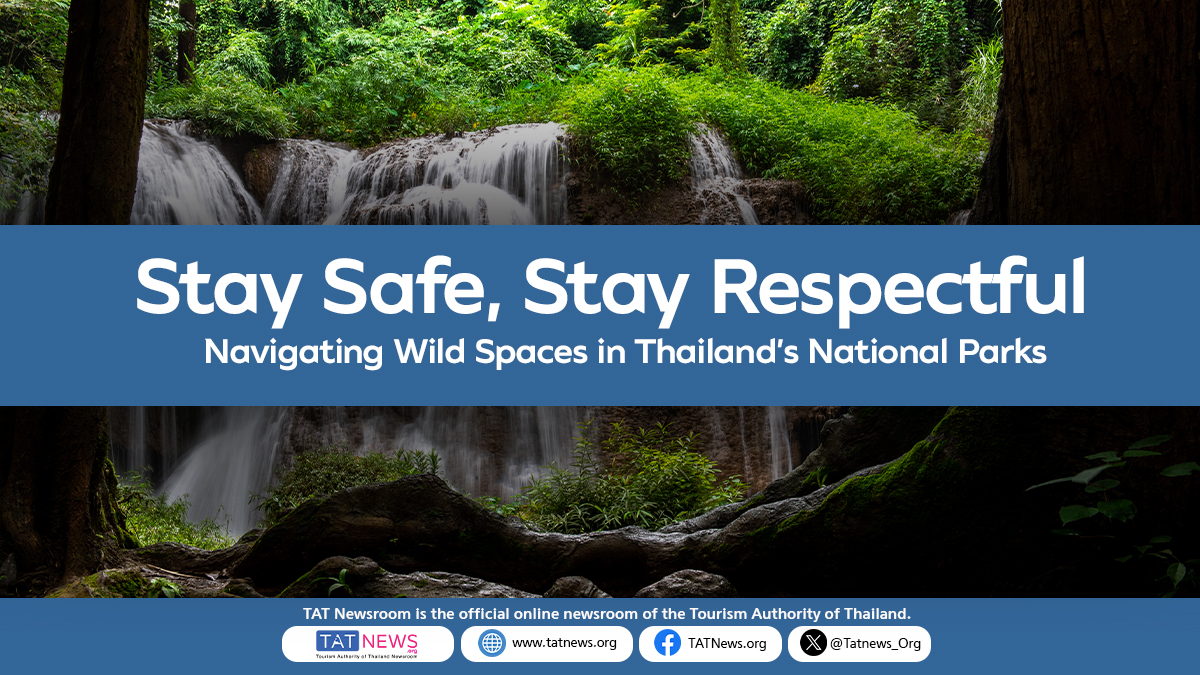Thailand’s natural beauty and diverse wildlife, especially its iconic elephants, are treasures to be enjoyed with care and responsibility. Whether trekking through lush national parks or driving in wildlife zones, following safety guidelines ensures visitors a safe and rewarding experience while protecting the animals and their habitats.
To help travellers navigate these wild spaces responsibly, TAT Newsroom has created an infographic outlining key safety tips. These include avoiding close interactions, refraining from feeding wildlife, staying on marked trails, recognising signs of aggression, and remaining calm in unexpected encounters.
It is important to note that while there are opportunities to observe elephants in their natural habitats, national parks do not provide organised elephant-watching activities. Visitors must follow park rules, remain on marked trails, and adhere strictly to park officials’ instructions to ensure safety and minimise animal disturbance.
Follow These Essential Guidelines to Stay Safe in Elephant Habitats:
While Trekking or Hiking
- Stay Calm and Quiet: Avoid shouting, sudden noises, or movements that may startle elephants. Stay quiet and avoid drawing attention to yourself.
- Use Natural Barriers: Place large objects, such as trees or rocks, between you and the animal to stay out of sight.
- Move Away Slowly: Do not run or turn your back. Retreat calmly and give the elephant space.
- Recognise Signs of Aggression: Watch for warning signs such as ears stiff and spread wide, intense staring, or a still or swinging trunk. Stay alert and ready to move.
- Drop Excess Gear: If an elephant charges, leave bags behind to move quickly and remain agile.
- Escape Strategy:
- Downhill: Run downhill if possible, as elephants avoid steep slopes.
- Flat Terrain: Move diagonally (45°) past large trees to slow the elephant’s pursuit.
- If You Trip: Stay calm, roll out of the elephant’s path, and get up quickly to continue running.
- Defensive Action: If cornered, use sticks or tools to aim at the elephant’s eyes or nails to distract it momentarily.
- Avoid Peak Activity: Stay away from isolated areas during dawn and dusk, when elephants and other wildlife are most active.
- Follow Park Rules: Stick to marked trails, travel in groups, and follow park officials’ instructions at all times.
While Driving in Wildlife Zones
- Maintain Distance: Stop at least 30 metres away to avoid provoking elephants.
- Stay Quiet: Avoid honking, shouting, or making sudden noises.
- Avoid Flash Photography: Never take close-up photos or use flash, as it can agitate elephants.
- Keep the Engine Running: Keep your vehicle engine on for a quick escape if necessary.
- Night Driving: Use low beams to monitor elephant movements without disturbing them.
- Stay Alert: Check all directions for elephant activity.
- Do Not Stop for Long: Avoid stopping to watch elephants, as this can cause congestion or accidents if other vehicles follow.
- Report Sightings: Inform park officials if you encounter elephants on the road or need assistance.
Observing Elephant Behaviour
- Calm Mood: Ears flapping, tail swaying, trunk moving freely, or casually pulling at branches to eat. These behaviours indicate the elephant is relaxed and uninterested in people.
- Signs of Aggression: Ears stiff and spread wide, tail raised, trunk still or striking the ground, and intense staring. Leave the area immediately if you observe these warning signs.
General Trekking Etiquette
- Do not take close-up photos or follow elephants.
- Stay quiet and store food securely to avoid attracting wildlife.
- Camp only in designated areas.
- Follow park officials’ instructions at all times.
- Stick to marked trails, and avoid isolated areas during dawn and dusk.
- Travel in groups whenever possible.
Remember:
Elephants are wild animals, not pets. Always treat them with respect and caution. By remaining calm, following park guidelines, and understanding elephant behaviour, you can enjoy Thailand’s natural beauty while ensuring safety for yourself and its magnificent wildlife.







